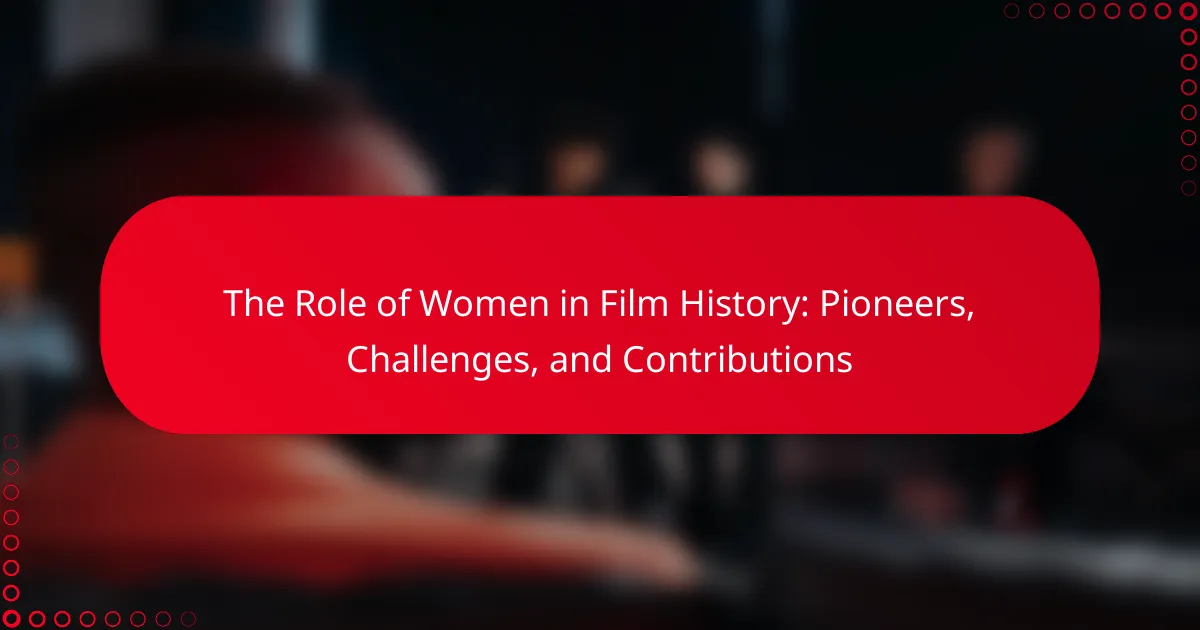Women have historically played a pivotal role in the film industry, serving as pioneers, creators, and influencers across various filmmaking domains, including directing, producing, writing, and acting. Notable figures such as Alice Guy-Blaché, the first female director, and Lois Weber, a prominent director and screenwriter, laid the groundwork for future generations. Despite facing ongoing challenges, the representation of women in film has gradually improved, with women currently occupying approximately 31% of key production roles and an increase in women directors in top-grossing films to around 12%. However, women of color remain underrepresented, highlighting the need for continued advocacy for gender equality in the industry. The article will explore the contributions of women to film history, the challenges they face, and the evolution of their representation in cinema.

What is the Role of Women in Film History?
Women have played a crucial role in film history as pioneers, creators, and influencers. They have contributed significantly to various aspects of filmmaking, including directing, producing, writing, and acting. Early film history saw women like Alice Guy-Blaché, the first female director, who made over 1,000 films. In the silent film era, actresses such as Mary Pickford became major stars and business figures. The 1970s feminist movement led to increased visibility and opportunities for women in the industry. Today, women continue to break barriers, with directors like Greta Gerwig and Ava DuVernay gaining critical acclaim. The representation of women in film has evolved, reflecting broader societal changes. Women’s contributions have shaped the narrative and artistic landscape of cinema throughout its history.
How have women influenced the development of film as an art form?
Women have significantly influenced the development of film as an art form through pioneering contributions and creative leadership. Early filmmakers like Alice Guy-Blaché were among the first to direct and produce films, establishing narrative storytelling techniques. Women have also excelled in screenwriting, with figures like Frances Marion winning two Academy Awards for her work in the 1920s and 1930s.
In addition to directing and writing, women have played crucial roles in editing and cinematography, shaping the visual language of cinema. Notable editors such as Thelma Schoonmaker have received accolades for their transformative work on iconic films. The emergence of female directors in contemporary cinema, like Ava DuVernay and Greta Gerwig, has further expanded the scope of storytelling and representation in film.
Women have also been instrumental in advocating for gender equality within the industry. Organizations like Women in Film have worked to promote and support female filmmakers. Their efforts have led to increased visibility and opportunities for women in various film roles.
Overall, women’s contributions to film have not only enriched the art form but have also challenged traditional narratives and opened doors for future generations of filmmakers.
What are the key milestones achieved by women in the film industry?
Women in the film industry have achieved several key milestones. In 1916, Alice Guy-Blaché became the first female director, paving the way for women in filmmaking. In 1939, Hattie McDaniel became the first African American woman to win an Academy Award for her role in “Gone with the Wind.” In 1975, Lina Wertmüller became the first woman nominated for an Academy Award for Best Director for “Seven Beauties.” In 1993, Jane Campion won the Palme d’Or at Cannes for “The Piano,” marking a significant achievement for women in international cinema. In 2018, Greta Gerwig’s “Lady Bird” received multiple Oscar nominations, highlighting women’s increasing recognition in mainstream film. In 2021, Chloé Zhao won the Best Director Oscar for “Nomadland,” becoming the second woman and first woman of color to achieve this honor. These milestones reflect the growing influence and recognition of women in the film industry.
How do these milestones reflect the changing societal roles of women?
Milestones in film history reflect the changing societal roles of women by showcasing their evolving representation and influence. Early films often depicted women in limited, stereotypical roles. As time progressed, women began to take on more complex characters and narratives. The introduction of female directors and writers marked a significant shift. For example, in the 1920s, women like Alice Guy-Blaché became pioneers in filmmaking. By the 1970s, films began to address women’s rights and social issues. This evolution in film mirrored broader societal changes, such as the women’s liberation movement. The increasing visibility of women in diverse roles demonstrated a shift towards gender equality. Overall, these milestones highlight women’s growing empowerment and representation in society.
What challenges have women faced in the film industry?
Women in the film industry have faced significant challenges, including gender discrimination and lack of opportunities. Historically, women have been underrepresented in key roles such as directors and producers. According to a 2020 report by the Center for the Study of Women in Television and Film, only 16% of directors of top-grossing films were women. This disparity limits women’s creative influence in storytelling. Additionally, women often encounter wage gaps compared to their male counterparts. The Annenberg Inclusion Initiative reported that female actors earned 25% less than male actors in leading roles. These challenges create barriers to entry and advancement for women in the industry. Furthermore, women face stereotypes and biases that can hinder their professional growth. Studies show that female characters are frequently portrayed in limiting ways, affecting the types of roles available to women. Overall, these challenges contribute to a systemic issue of inequality within the film industry.
What barriers have historically limited women’s participation in filmmaking?
Barriers that have historically limited women’s participation in filmmaking include systemic gender discrimination and lack of access to funding. Women have often faced exclusion from key decision-making roles in the industry. Historically, film schools have been male-dominated, limiting women’s training opportunities. Additionally, societal expectations have often prioritized women’s roles in domestic settings over professional aspirations. The Hollywood studio system favored male directors, reducing opportunities for women. Research indicates that only 16% of directors were women in 2019, according to the Center for the Study of Women in Television and Film. Furthermore, harassment and a lack of mentorship have created hostile environments for aspiring female filmmakers. These factors collectively hindered women’s contributions to the film industry.
How have these challenges evolved over time?
Challenges faced by women in film have evolved significantly over time. Initially, women encountered barriers in gaining access to directing and producing roles. Early cinema featured women primarily in acting positions, limiting their influence. The 1920s saw some women break into directorial roles, yet societal norms still restricted their opportunities. The feminist movements of the 1960s and 1970s ignited a push for equality in the film industry. This period led to increased awareness and advocacy for women’s rights in cinema. By the 1990s, more women began to occupy leadership roles in film production. Recent years have seen initiatives aimed at increasing female representation in various facets of filmmaking. Studies show that films directed by women often perform well, indicating a shift in industry perceptions.
What contributions have women made to film history?
Women have made significant contributions to film history in various roles. They have been directors, producers, writers, and actors, shaping the industry. Pioneers like Alice Guy-Blaché were among the first filmmakers, directing over 1,000 films in the early 1900s. Frances Marion became the first woman to win an Oscar for screenwriting in 1929.
Women have also influenced film through advocacy for representation and equality. The Geena Davis Institute on Gender in Media highlights gender disparity in film. Studies show that films with female directors tend to feature more female characters.
Moreover, women have contributed to technical aspects of filmmaking. Cinematographer Rachel Morrison became the first woman nominated for an Oscar in cinematography in 2018. Women have also shaped the narrative by bringing diverse perspectives to storytelling.
Overall, women’s contributions have been vital in evolving the film industry and promoting inclusivity.
Which notable female filmmakers have shaped the industry?
Notable female filmmakers who have shaped the industry include Kathryn Bigelow, Sofia Coppola, and Ava DuVernay. Kathryn Bigelow is known for directing “The Hurt Locker,” which won six Academy Awards, including Best Picture. Sofia Coppola gained acclaim for “Lost in Translation,” earning her an Oscar for Best Original Screenplay. Ava DuVernay directed “Selma,” which highlighted civil rights history, and became the first African American woman to direct a film nominated for Best Picture. These filmmakers have made significant contributions that have influenced cinematic storytelling and representation in the film industry.
What unique perspectives do women bring to storytelling in film?
Women bring diverse emotional depth and nuanced character development to storytelling in film. Their experiences often highlight themes of resilience, empathy, and social justice. Female filmmakers frequently incorporate unique cultural perspectives that may be overlooked by male counterparts. This can lead to richer narratives that resonate with a broader audience. Research indicates that films directed by women often feature more complex female characters. For example, a study by the Geena Davis Institute on Gender in Media found that women are underrepresented in film, yet films with female leads perform well at the box office. Their storytelling often challenges stereotypes and promotes authenticity. This unique viewpoint fosters inclusivity and encourages dialogue on important societal issues.

Who are the pioneers of women in film history?
Alice Guy-Blaché is recognized as one of the pioneers of women in film history. She was the first female director and made over 1,000 films in the early 1900s. Lois Weber was another trailblazer, known for her directing and screenwriting in the silent film era. She was one of the highest-paid directors of her time. Dorothy Arzner was the first woman to join the Directors Guild of America. She directed films during the 1920s and 1930s and is known for her strong female characters. Frances Marion was a prolific screenwriter, winning two Academy Awards for Best Adapted Screenplay. These women made significant contributions to the film industry, shaping its early development and paving the way for future generations.
What impact did early female filmmakers have on cinema?
Early female filmmakers significantly influenced cinema by pioneering storytelling techniques and challenging gender norms. They introduced innovative narrative styles that expanded the possibilities of film as an art form. For example, Alice Guy-Blaché, one of the first female directors, created over 1,000 films and was a pioneer in using synchronized sound. Lois Weber, another early filmmaker, was known for her socially conscious themes, addressing issues like women’s rights and poverty.
These filmmakers not only contributed to the technical aspects of filmmaking but also brought diverse perspectives to the industry. Their work laid the groundwork for future generations of female filmmakers. Despite facing significant challenges, such as limited access to funding and industry recognition, their contributions helped shape the evolution of cinema. The impact of early female filmmakers remains evident in today’s film landscape, where their legacy continues to inspire new voices.
Who are some of the most influential women in the silent film era?
Mary Pickford, Lillian Gish, and Clara Bow are some of the most influential women in the silent film era. Mary Pickford was known as “America’s Sweetheart” and co-founded United Artists. Lillian Gish is celebrated for her exceptional acting skills and contributions to film techniques. Clara Bow became a symbol of the “Roaring Twenties” and was a major box office star. Their work significantly shaped the film industry and paved the way for future generations of actresses.
How did their work challenge traditional gender roles in filmmaking?
Their work challenged traditional gender roles in filmmaking by showcasing female perspectives and narratives. Women filmmakers often focused on stories that highlighted women’s experiences and struggles. This approach shifted the male-dominated storytelling paradigm in cinema. For instance, pioneers like Dorothy Arzner and Lina Wertmüller created complex female characters. Their films often addressed social issues related to gender inequality. Statistics show that films directed by women earned critical acclaim and recognition. This success demonstrated that women’s voices are vital in the industry. Overall, their contributions helped redefine the role of women both in front of and behind the camera.
How did women contribute to the Golden Age of Hollywood?
Women significantly contributed to the Golden Age of Hollywood through various roles in filmmaking. They were pivotal as actresses, directors, producers, and screenwriters. Iconic actresses like Katharine Hepburn and Bette Davis shaped the film industry with their powerful performances. Women also held influential behind-the-scenes positions, such as Dorothy Arzner, one of the first female directors in Hollywood.
In addition, women contributed to the screenplay writing process, creating compelling narratives that resonated with audiences. The presence of female producers helped finance and promote films that featured strong female characters. Furthermore, women’s contributions extended to the technical side, with women working as editors and cinematographers.
Historical data shows that during the 1930s and 1940s, women made up a significant portion of the workforce in Hollywood, despite facing systemic challenges. Their work laid the groundwork for future generations of women in film, influencing both the industry and popular culture.
What roles did women play behind the camera during this period?
Women played significant roles behind the camera during this period. They worked as directors, producers, writers, and editors. Many women contributed to the development of early cinema. For example, Alice Guy-Blaché was one of the first female directors. She directed over 1,000 films between 1896 and 1920. Frances Marion became a prominent screenwriter, winning two Academy Awards. Additionally, women like Dorothy Arzner broke barriers as directors in the 1930s. These contributions were crucial in shaping the film industry. Women’s involvement helped diversify storytelling and perspectives in cinema.
How did female stars influence the portrayal of women on screen?
Female stars significantly influenced the portrayal of women on screen by challenging traditional gender roles. They showcased a range of complex female characters, moving beyond stereotypes. Actresses like Katharine Hepburn and Bette Davis portrayed strong, independent women. Their performances encouraged filmmakers to create more nuanced female roles. This shift began in the 1930s and continued through the 1960s. The impact of these stars is evident in the increased visibility of women in diverse narratives. Research indicates that female-led films often perform well at the box office, reflecting audience demand for strong female characters. Thus, female stars played a crucial role in transforming cinematic representations of women.

What is the current state of women in the film industry?
Women in the film industry currently face significant challenges but are increasingly gaining recognition and opportunities. As of 2023, women hold approximately 31% of key behind-the-scenes roles in film production. This includes positions such as directors, writers, and producers. The percentage of women directors in the top-grossing films has risen to around 12%, a notable increase from previous years. However, women of color remain underrepresented, comprising only 4% of directors in major films. Various initiatives and organizations are advocating for greater gender equality in the industry. The #MeToo movement has also sparked discussions about harassment and discrimination in film. Despite progress, the industry still has a long way to go to achieve true parity.
How do contemporary women filmmakers differ from their predecessors?
Contemporary women filmmakers differ from their predecessors primarily in their increased representation and influence in the industry. They often have more opportunities to direct, produce, and write films. This shift has led to a wider variety of narratives and perspectives being showcased in cinema. For example, films directed by contemporary women frequently address social issues, personal stories, and diverse experiences. In the past, women filmmakers faced significant barriers, such as limited access to funding and industry networks. Today, initiatives like the 50/50 by 2020 campaign aim to achieve gender parity in film. Statistics show that the percentage of women directors has increased from 5% in the 1990s to around 20% in recent years. This growth reflects a broader cultural change towards inclusivity and representation in the film industry.
What initiatives are in place to support women in film today?
Numerous initiatives support women in film today. Organizations like Women in Film (WIF) provide resources and networking opportunities. They focus on mentorship, grants, and educational programs. The Sundance Institute has a program specifically for female filmmakers. It offers funding and development support for women-led projects. The Geena Davis Institute on Gender in Media conducts research on gender representation in film. Their findings influence industry practices and promote equality. Additionally, the #MeToo movement has sparked discussions on workplace safety and equity. These initiatives collectively aim to empower women and enhance their visibility in the film industry.
How can the film industry further promote gender equality?
The film industry can further promote gender equality by increasing the representation of women in key roles. This includes hiring more female directors, writers, and producers. Research shows that films directed by women tend to have more female characters and stronger narratives around gender issues. For instance, a study by the Geena Davis Institute on Gender in Media found that women directed only 12% of the top-grossing films in 2019. Additionally, the industry can implement mentorship programs for aspiring female filmmakers. This creates pathways for women to enter and succeed in the industry. Furthermore, promoting gender-sensitive training for all industry professionals can foster a more inclusive environment. By establishing clear diversity goals and accountability measures, the film industry can ensure lasting change.
What lessons can be learned from the history of women in film?
The history of women in film teaches the importance of representation and diversity. Women have played crucial roles both in front of and behind the camera. Historical figures like Alice Guy-Blaché were among the first filmmakers, demonstrating women’s capabilities in storytelling. The challenges women faced, such as discrimination and limited opportunities, highlight the need for advocacy. The rise of female directors and writers in contemporary cinema shows progress and potential for change. Statistics indicate that films with women in key roles perform better at the box office. The evolution of women’s roles in film illustrates the ongoing struggle for equality in the industry. These lessons emphasize the significance of supporting women in film to foster a more inclusive future.
What strategies have proven effective for women in overcoming industry barriers?
Networking and mentorship have proven effective for women in overcoming industry barriers. Building connections with industry professionals can provide guidance and support. Mentorship programs often help women navigate challenges and access opportunities. Education and skill development are also critical. Women who pursue formal training in film-related fields enhance their qualifications. Advocacy for gender equality within organizations can lead to policy changes. Research indicates that companies with diverse leadership perform better. Collaborating on projects with other women creates supportive environments. These strategies collectively empower women to succeed in the film industry.
How can aspiring female filmmakers apply these lessons in their careers?
Aspiring female filmmakers can apply lessons from film history by studying the strategies of successful pioneers. They should analyze how these women navigated challenges in a male-dominated industry. Understanding the historical context can empower them to overcome similar obstacles today. Networking with other women in the industry is crucial for support and collaboration. They can also seek mentorship from established filmmakers to gain valuable insights. Additionally, aspiring filmmakers should advocate for diverse storytelling, reflecting their unique perspectives. Engaging with film festivals that promote female filmmakers can provide exposure and opportunities. By embracing these lessons, they can carve out their own paths in the industry.
The main entity of this article is the historical and contemporary role of women in film. It outlines the significant contributions of women as pioneers, creators, and influencers in the film industry, highlighting key milestones such as Alice Guy-Blaché’s directorial achievements and the impact of the feminist movement on women’s visibility in cinema. The article also addresses the challenges women have faced, including gender discrimination and underrepresentation in key roles, while showcasing the ongoing evolution of women’s roles in filmmaking. Additionally, it discusses the unique perspectives women bring to storytelling and the current initiatives aimed at promoting gender equality in the film industry.
